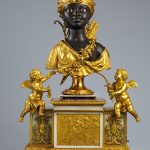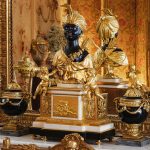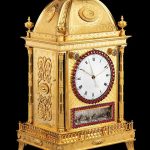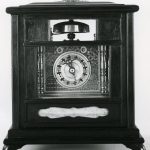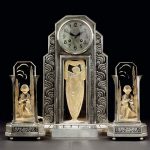Musical Mantel Clocks. Mantel clocks are ideal for musical movements and have graced stately homes for centuries. Below are some examples of musical mantel clocks including an African Princess clock by Jean-Baptiste-Andre Furet and a Louix XV bronze and ormolu clock.
Mantel clock with musical movement ca. 1784 Clockmaker: Jean-Baptiste-André Furet
This clock is shaped like the bust of an African princess. The unusual model had already attracted attention during the late eighteenth century, according to a description in the anonymous chronicle Mémoires secrets, for July 4, 1784: “The curious are going to M. Furet’s shop in the rue Saint-Honoré to see three extraordinary clocks of his creation. The first represents the bust of a negress exceptionally made. . . . Upon pulling one ear-ring the hour is described in the right eye and the minutes in the left. Upon pulling the other a musical movement plays a succession of airs.” This particular clock was not long afterward acquired for the royal collection, but the model was repeated several times with small variations. One of them, signed by Furet, clockmaker to the king, is the Museum’s version. The dark, enameled surface of the bust contrasts beautifully with the clothing and accoutrements of gilt bronze, such as the turban with its tuft of plumes and the fur-trimmed robe, as well as the openwork earrings, the string of graduated beads, the floral garland, and the bow and quiver. Whereas the head and chest contain the clock movement, the marble plinth below serves as a case for the musical movement, a tiny pipe organ, which could once be activated by pulling the earring on the figure’s right ear but no longer functions. That such musical movements were delicate is illustrated by the fact that the example at the French court was already in need of repair three times during the late eighteenth century.
The passage of time is not usually visible in this highly decorative clock. On the hour, the music would play and the eyes would open, showing the hour in roman numerals (i–xii) in the woman’s right eye and the minutes in arabic numerals (2–60) in the left. However, by pulling the earring on her left ear the eyes could be opened at any time.
Reference: The Metropolitan Museum of Art
An ormolu and patinated-bronze mounted, white and black marble musical and automaton mantel clock, Louis XVI, Paris, circa 1784, the mechanism by Jean-Baptiste-André Furet and François-Louis Godon, the gilt-bronze base attributed to Etienne Martincourt the head wearing a turban with plumed feathers, the eyes indicating the hours and the minutes, the draped bust with a quiver and a bow to the back and a floral garland sash across the front, the pedestal on a stepped gilt bronze and marble breakfront base flanked by putti, the base enclosing an organ, the gilt bronze mounts depicting children playing with a dog in the clouds, vases with flowers, the sides with caduceus and petasus, on toupee feet, the movement signed FURET ET GAUDON HORLOGERS DU ROI under the turban and Furet et Godon horlogers Du Roi, a Paris in front of the musical cylinder Haut. 72 cm, larg. 41 cm, prof. 23 cm ; height 28⅓in., width 16in., depth 9in.
Sold for 1,452,500 EUR at Sotheby’s in 2019
HENRY BORRELL, LONDON. A MAGNIFICENT AND LARGE CHASED AND ENGRAVED ORMOLU QUARTER STRIKING MUSICAL CLOCK WITH AUTOMATA ‘SAILING SHIPS’, MADE FOR THE CHINESE MARKET, CIRCA 1795 Year: Circa 1795 Movement: Large three train chain fusee movement striking on bells, rack striking on a nest of eight bells playing two musical tunes, playing on the hour or at will through a button on the side of the case, highly decorative engraved floral and scroll back-plate, when the music is activated the engraved panel raises to reveal an automaton scene of painted ships and galleons on a realistically portrayed sea, the sea replicated by twisted glass rods turning within the automaton. Dial: White enamel dial with Roman numerals, centre seconds, the bezel set with red paste stones, similarly decorated paste setting to the rectangular aperture surrounding the concealed automaton scene Case: The exquisitely and finely chased and engraved ormolu case with floral motifs throughout, applied highly detailed balustrading work and finely shaped and engraved feet, pierced and engraved door revealing the movement Dimensions: 655mm High, 285mm Length, 365mm Wide at the base.
Sold for HK$ 3,875,625 (£ 377,293) inc. premium at Bonham’s in 2019
Small mantel clock; brass movement; pendulum; strike; revolving dial; double calendar; front-plate with geometric designs in colours; engraved front and back plates; turned baluster columns; rectangular base with musical box action; ebonised case with glazed sliding panel.
Reference: © The Trustees of the British Museum
A LOUIS XV PATINATED BRONZE, ORMOLU AND RED HORN STRIKING MANTEL CLOCK ON MUSICAL PLINTH: ‘PENDULE AU SANGLIER’ THE CLOCK BY HENRI VOISIN, PARIS, MID-18TH CENTURY, THE PLINTH MID-18TH CENTURY AND ASSOCIATED CASE: modelled as a patinated bronze wild boar on naturalistic rockwork-cast base with scrolling foliate feet, supporting a drum case with floral spray mounts and topped by a seated Chinaman with umbrella, mounts re-gilt DIAL: white enamel, signed ‘HENRI VOISIN/A PARIS’, pierced ormolu hands MOVEMENT: rectangular plates with cut corners, twin barrels with silk suspension and countwheel strike on bell, with repeat signature; pendulum, key THE PLINTH: the associated gilt-decorated red-stained horn shaped plinth with foliate scrolled mounts and gadrooned border, the front centred by a red silk-backed pierced brass sound fret with ormolu musical trophy mount, a further fretted panel to each side, the rear fabric-covered and with fret panel, housing possibly associated pinned cylinder musical movement (eleven bells, nineteen hammers), on out-scrolled feet, the underside with printed paper label inscribed ‘SHELBURNE’ below an earl’s coronet, also with red painted inventory number ‘M.H/6185’ 37 in. (94 cm.) high overall; the plinth alone: 13¼ in. (34 cm.) high; 22 in. (56 cm.) wide; 14 in. (35.5 cm.) deep; the clock: 24 in. (61 cm.) high; 15 in. (38 cm.) wide; 6¼ in. (16 cm.) deep
Sold for GBP 181,250 at Christie’s in 2010
A rare French Louis XVI ormolu bronze and marble musical portico mantel clock. Ca. 19th century. Dimensions: H: 19 1/5 in., (49.5 cm.)
Sold for $2,250 at HELIOS Auctions in 2019
